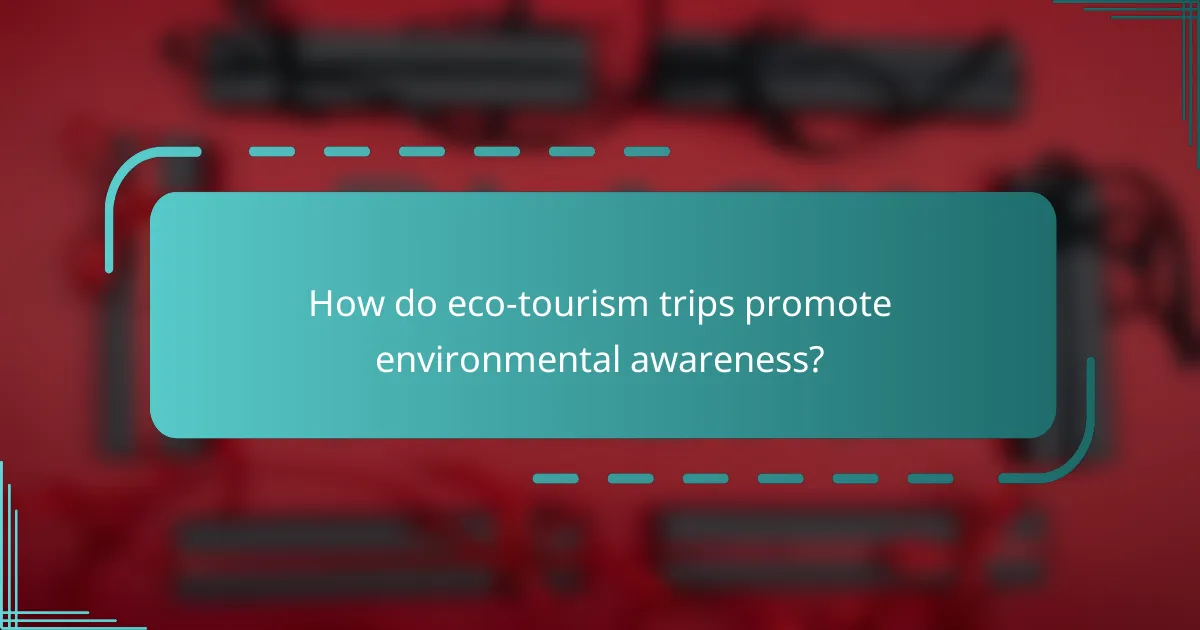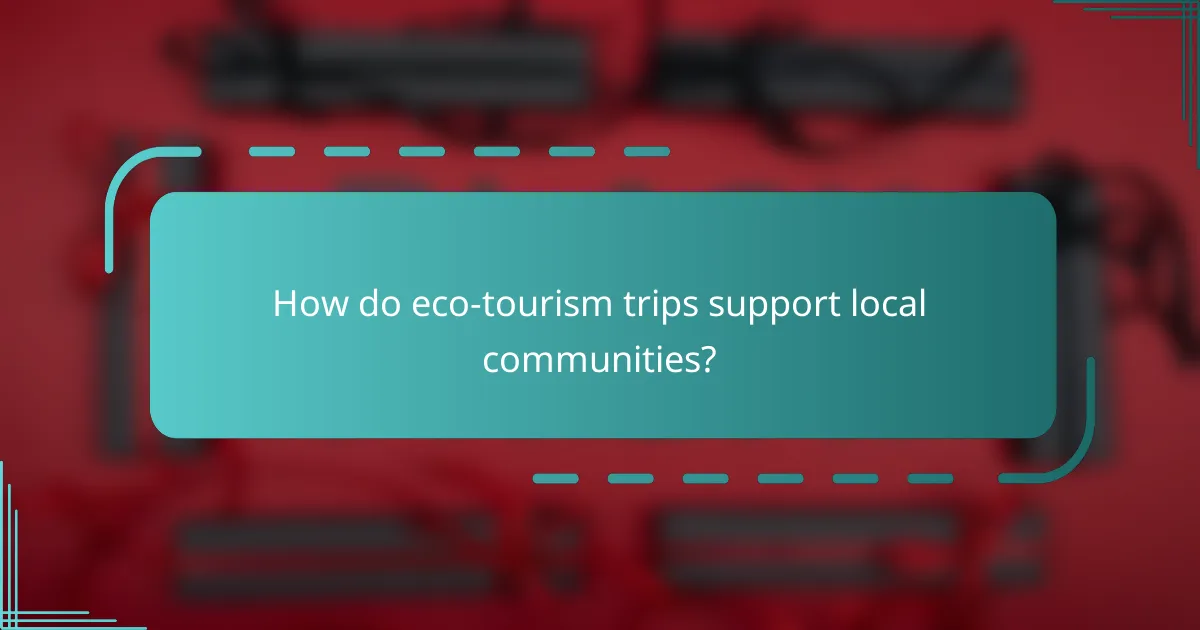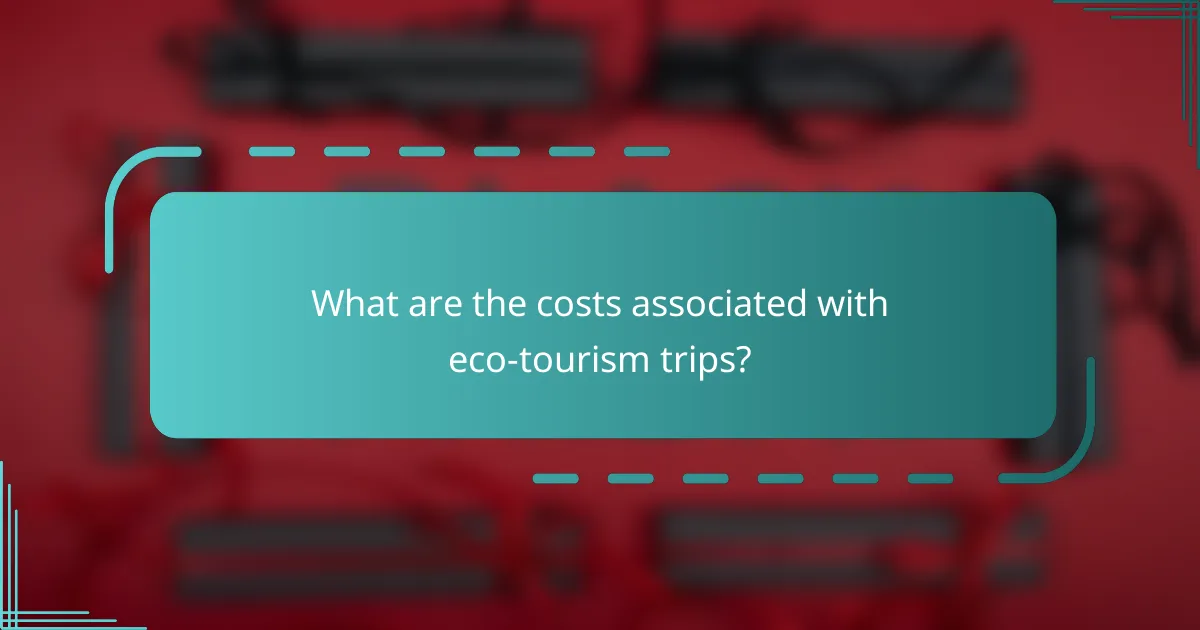Eco-tourism trips provide a unique opportunity to explore stunning natural environments while fostering environmental awareness and appreciation for wildlife. By engaging with local communities and supporting sustainable practices, travelers can contribute to conservation efforts and experience the beauty of diverse ecosystems firsthand. These journeys not only educate participants about the importance of biodiversity but also encourage responsible interactions with nature.

What are the best eco-tourism trips in Costa Rica?
Some of the best eco-tourism trips in Costa Rica include visits to Monteverde Cloud Forest Reserve, Corcovado National Park, and Osa Peninsula Wildlife Tours. These destinations offer unique opportunities for environmental awareness, wildlife appreciation, and community support while immersing travelers in lush ecosystems.
Monteverde Cloud Forest Reserve
Monteverde Cloud Forest Reserve is renowned for its rich biodiversity and unique cloud forest ecosystem. Visitors can explore numerous trails that showcase a variety of flora and fauna, including over 400 species of birds. Guided tours often provide insights into conservation efforts and the importance of preserving this delicate environment.
When planning a visit, consider the best times to go, typically during the dry season from December to April. Be prepared for cooler temperatures and occasional rain, which contribute to the forest’s lushness. Booking a guided tour can enhance your experience by offering expert knowledge and ensuring you don’t miss key highlights.
Corcovado National Park
Corcovado National Park is one of the most biodiverse places on Earth, making it a prime destination for eco-tourism. The park is home to a variety of wildlife, including jaguars, tapirs, and scarlet macaws. Hiking through its trails allows visitors to witness the stunning landscapes and diverse ecosystems firsthand.
To visit Corcovado, you typically need to arrange guided tours, as access is limited to protect the environment. It’s advisable to book in advance, especially during peak tourist seasons. Be sure to pack essentials like water, snacks, and insect repellent, as facilities within the park are minimal.
Osa Peninsula Wildlife Tours
The Osa Peninsula offers exceptional wildlife tours that focus on the region’s unique ecosystems. Visitors can engage in activities such as birdwatching, snorkeling, and hiking, all while learning about local conservation efforts. The area is known for its pristine beaches and rich marine life, making it a paradise for nature enthusiasts.
When participating in wildlife tours, choose operators that prioritize sustainable practices and support local communities. Look for options that include educational components to enhance your understanding of the area’s ecology. Always respect wildlife and maintain a safe distance to ensure both your safety and the animals’ well-being.

How do eco-tourism trips promote environmental awareness?
Eco-tourism trips enhance environmental awareness by immersing travelers in natural settings while educating them about conservation efforts. Participants gain insights into local ecosystems, the importance of biodiversity, and sustainable practices that protect the environment.
Conservation education programs
Conservation education programs are integral to eco-tourism, providing travelers with knowledge about local wildlife and habitats. These programs often include guided tours led by experts who explain the ecological significance of various species and ecosystems.
For example, a trip to a rainforest may feature workshops on the role of trees in carbon sequestration and the impact of deforestation. Engaging in hands-on activities, such as tree planting or habitat restoration, reinforces the lessons learned and fosters a deeper connection to the environment.
Wildlife protection initiatives
Wildlife protection initiatives are a cornerstone of eco-tourism, focusing on safeguarding endangered species and their habitats. Tour operators often collaborate with local conservation organizations to support efforts that mitigate poaching and habitat destruction.
Travelers may participate in activities like wildlife monitoring or community outreach, which directly contribute to the protection of local fauna. For instance, in regions where sea turtles are threatened, eco-tourism may involve beach clean-ups and educational programs that promote responsible tourism practices.

What wildlife can you appreciate on eco-tourism trips?
Eco-tourism trips offer a unique opportunity to appreciate diverse wildlife in their natural habitats. Travelers can engage in activities that promote environmental awareness while observing animals in a responsible manner.
Endangered species viewing
Endangered species viewing allows eco-tourists to witness rare animals that are often at risk of extinction. This experience not only fosters appreciation for these creatures but also raises awareness about conservation efforts. Popular destinations for viewing endangered species include national parks and wildlife reserves where guided tours ensure minimal disturbance to the animals.
When planning an endangered species viewing trip, consider the specific regulations in place to protect these animals. For instance, some areas may require permits or have restrictions on the number of visitors allowed. Always choose reputable tour operators who prioritize ethical practices.
Birdwatching experiences
Birdwatching experiences are a highlight of eco-tourism, attracting enthusiasts eager to observe various bird species in their natural environments. Locations such as wetlands, forests, and coastal areas are ideal for spotting both migratory and resident birds. Many eco-tourism trips offer guided birdwatching tours that enhance the experience with expert insights.
To make the most of your birdwatching experience, bring binoculars and a field guide to help identify species. Early mornings are often the best time for birdwatching, as many birds are more active during this period. Additionally, consider joining local birdwatching groups or workshops to deepen your understanding and appreciation of avian wildlife.

How do eco-tourism trips support local communities?
Eco-tourism trips play a vital role in supporting local communities by promoting sustainable practices that benefit both the environment and the economy. These trips often prioritize local engagement, ensuring that a portion of the revenue generated directly supports community development and conservation efforts.
Community-based tourism projects
Community-based tourism projects involve local residents in the planning and management of tourism activities, ensuring that they receive direct benefits. These initiatives often focus on preserving cultural heritage and natural resources while providing visitors with authentic experiences. For example, a village may offer guided tours showcasing traditional crafts or local wildlife, with profits reinvested into community services.
When participating in these projects, travelers should seek out operators that are transparent about how funds are allocated. Engaging with local leaders can also enhance the experience, as they can provide insights into the community’s needs and aspirations.
Local artisan support
Supporting local artisans is a key aspect of eco-tourism that fosters economic growth within communities. Tourists can purchase handmade crafts, textiles, and artwork, which not only provides income for artisans but also helps preserve traditional skills and cultural identity. This direct support often leads to improved living standards and community pride.
Travelers should consider visiting artisan markets or workshops where they can interact with creators. This not only enriches the travel experience but also ensures that their purchases contribute to sustainable livelihoods. Additionally, being aware of fair trade practices can help ensure that artisans receive a fair price for their work.

What criteria should you consider when choosing an eco-tourism trip?
When selecting an eco-tourism trip, prioritize the environmental sustainability of the activities, the level of community engagement, and the overall impact on local wildlife. Look for operators that adhere to recognized eco-certifications and actively contribute to conservation efforts.
Environmental impact assessments
Environmental impact assessments (EIAs) evaluate the potential effects of tourism activities on ecosystems. These assessments help ensure that trips do not harm local wildlife or habitats. When choosing an eco-tourism trip, check if the operator conducts regular EIAs and incorporates their findings into their operations.
Look for tours that minimize carbon footprints, such as those using renewable energy sources or promoting low-impact transportation. Operators that provide transparency about their environmental practices often have a stronger commitment to sustainability.
Community involvement
Community involvement is crucial for a successful eco-tourism trip. Choose operators that engage local communities in decision-making processes and share economic benefits with them. This can include hiring local guides, sourcing food from nearby farms, or supporting local artisans.
Consider trips that offer opportunities for cultural exchange, such as workshops or community projects. These experiences not only enrich your travel but also foster a sense of responsibility towards the communities you visit, ensuring that tourism contributes positively to their livelihoods.

What are the costs associated with eco-tourism trips?
The costs of eco-tourism trips can vary widely based on location, duration, and the type of experiences offered. Generally, travelers should expect to pay for accommodations, meals, transportation, and activities that support environmental conservation and local communities.
Average trip pricing
On average, eco-tourism trips can range from a few hundred to several thousand dollars. For instance, a week-long eco-lodge stay in Central America might cost between 700 and 1,500 USD, while a guided wildlife safari in Africa could exceed 3,000 USD. Prices often reflect the level of sustainability and community involvement.
It’s essential to consider what is included in the pricing. Some packages cover meals, tours, and transportation, while others may charge extra for specific activities or amenities. Always check the details to avoid unexpected expenses.
Budget-friendly options
For those seeking budget-friendly eco-tourism options, consider local or regional trips that require less travel. Camping in national parks or participating in community-led tours can significantly reduce costs, often ranging from 50 to 150 USD per day.
Additionally, look for off-season travel opportunities, which can lower prices for accommodations and activities. Many eco-tourism providers offer discounts for group bookings or extended stays, making it easier to enjoy sustainable travel without overspending.
